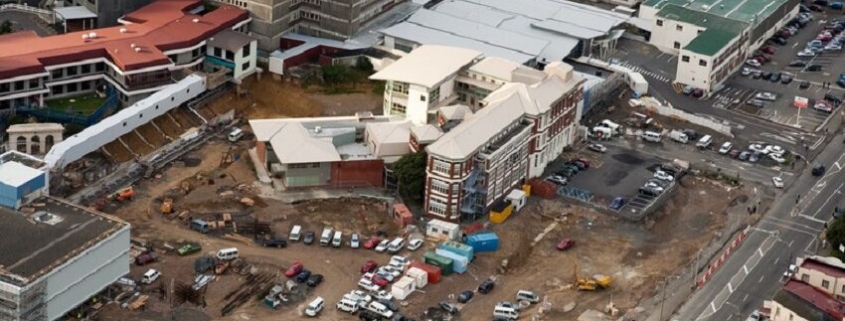Look Who’s Investing In Healthcare
Commercial real estate has been in a whirlwind.
Industrial properties are incredibly hot—and expensive with subterranean cap rates. Multifamily is nearly as in demand, but many keep wondering if the end of federal Covid unemployment assistance combined with significant unemployment and the Delta variant could pull a rug out from under the sector.
You could look at the office and wonder when companies will be fully back; retail and remember e-commerce continues to grow; self-storage and ask when demand could max out; or you could look for a different investment prescription.
Medical real estate has a lot going for it: an economic sector that represents 17.7% of U.S. GDP, tenants with high credit and financial strength, and a customer base for which services are a literal matter of life and death.
“There’s always been investors with a healthcare strategy,” Andrew Twito, vice president of capital markets at Ryan Companies, says. “In the last 12 to 18 months, essentially every type of investor has been evaluating the sector. What they’re finding now is it’s an attractive place to deploy capital because it’s a defensive sector during a recession. People still get sick, they still have to go to the hospital, and they still have to get treated.”
Medical also means following big changes in healthcare delivery and structures and facing popular distrust in skilled nursing and elder care segments. Opportunity, for those who want to jump in, needs some preparation and a reexamination of the landscape.
Transformation Of The Medical Office
“Medical office is doing well,” Bo Stuart, a senior associate at Transwestern’s Southeast healthcare advisory services team, tells GlobeSt.com. “It started coming out of the pandemic earlier than certain product types and there was less uncertainty.”
The cap rates are relatively good compared to, say, threes in industrial.
“I’ve seen anywhere from stuff in the fours to a lot of stuff in the fives,” says Ben Reinberg, founder and CEO of Alliance Consolidated Group of Companies. “You have short term leases that trade in the sixes and sevens.”
Investment rewards are nothing new to those with experience investing in the sector. John Wilson, president of HSA PrimeCare, points out that the medical office building, or MOB, sector performed well in the financial crisis of 2008 through 2012.
“It not only remains strong, but I think the pandemic has accelerated the growth and number of investors and it’s brought new capital because of some of the fundamentals of the space, comparing it to general office,” Wilson says. “General office is still facing the uncertainty of employees coming back, when they’re going to come back, how many are going to come back. Medical office shows more clarity in long-term demand.”
This hasn’t been a surprise to those like Robert Atkins, a principal at Atkins Companies, whose multigenerational family firm, with 700,000 square feet of medical office space, was in MOB “way before it was considered a separate asset class.”
“Having a lot of different asset classes through the years, residential, retail, general office, we decided years ago to focus almost exclusively on medical office,” Atkins says. “We believed it was one of the most attractive and stable asset classes in our experience through the various peaks and valleys of the real estate market.”
However, for all the benefits, this isn’t a market to nonchalantly enter.
“Healthcare is a very complex industry,” says Alfonzo Leon, CIO, Global Medical REIT, who has been in the space since 2005. “The thing that always stood out for me when I compared it to apartments or office or retail, it takes a long time to make sense of the healthcare landscape. Apartments are pretty straightforward, with a lot of demographic analysis. In healthcare, you also have demographic analysis, but it’s more complex. There are relationships between hospitals and physicians, payment issues, a lot of regional stuff, each city has its own dynamic and history. Then you get into the insurance companies. I felt like it took me five years to feel I understood what I was looking at and what the risks were.”
For example, demographics will direct which types of practices will thrive in specific areas. As the dynamics of the relationships change, so do the fundamentals of associated real estate investment.
“If you go back 20 or 25 years, you had mom and pop practices,” says Wilson. That is increasingly rare.
Atkins has watched the evolution of single practitioners getting swallowed up by larger medical practices or hospitals.
“It’s almost impossible now for a young doctor to come out and hang his shingle,” Atkins says, because the economics are unfeasible with student debt, insurance, and the cost to buy or establish a new practice. “The only single practitioners and single groups you see are the old timers finishing out their careers and who don’t want to get involved with the larger groups.”
Where once the primary tenants for medical offices were small practices, now it’s large-scale medical systems, hospitals, and private equity groups acquiring specialty practices.
“We’re in North Jersey in Essex county,” Atkins says. “Our home office is in the building but we’re the only non-medical office.” The tenant next door was an oral surgery group of four doctors, with multiple locations, reaching retirement. “They sold out to a younger oral surgeon, an aggressive guy buying a bunch of these practices, and he just re-upped on a new 10-year lease. This group of doctors had a strong reputation.” The young doctor wanted to keep it.
But such examples are minor compared to the larger healthcare industry forces at work, which are visible in both leasing and construction.
New Developments And Leasing
“There’s a backlog of projects,” says Doug King, national healthcare sector leader at Project Management Advisors. “Healthcare, there’s a backlog of projects that were probably already on their radar.” “What clients are building are the outpatient or ambulatory care facilities being planted in neighborhoods in urban areas. They’re outpatient services, but also have diagnostics or treatments that are fairly sophisticated. There’s a fair amount of money out there for community health and public health.”
There are even moves to have some overnight beds.
“They’re allowing observation beds in some areas so you’re able to do them in a lower cost structure and keep the patient safe,” says William Colgan, a managing partner at CHA Partners.
The same pattern appears in leasing, as large organizations set up treatment centers that are far less expensive to run than traditional hospitals but with enough resources to provide more expansive care than clinics.
“You see money migrating to those types of facilities,” Colgan says. “Smaller types of office buildings are less attractive. The larger, consolidated healthcare services under one roof for convenience is where you find money chasing. What used to happen in healthcare, every doc was an entrepreneur. We have a whole new generation of docs that are all employees.”
The change in healthcare delivery—due largely because of the complexities and realities of much more “risk-based reimbursement” of providers, as Colgan notes—has changed what potential tenants want in buildings.
“The old-style medical office building had small suites,” says Mindy Berman, senior managing director and co-head of JLL’s healthcare capital markets group. “Some of them are in good real estate locations and will be adapted, not that hard. These newer models need more infrastructure.” Heavier equipment requires more floor load and power.
Even the number of columns, column spacing, and floor to ceiling height become important.
“If you get an eight or eight-and-a-half foot ceiling, it’s somewhat confining,” HSA PrimeCare’s Wilson says.
More space also reduces the anxiety levels of patients, improving the experience and presumably making them more likely to come back rather than to choose another facility.
Skilled Nursing And Senior Care
There are long-term forces at work in skilled nursing and senior care as well, but also shorter-term reactions to pandemic experiences. Think of all the stories about nursing home residents dying from Covid-19.
“Every two to six weeks you see a New York Times story about nursing homes,” says Don Husi, a managing director of privately-held investment bank Ziegler, which does a lot of work in healthcare and senior living. “There’s a group of people out there doing their best to give our industry a bad name without outlining the good things we’re doing.”
Husi and some others in that part of the industry thought that ultimately the criticism was forced and ignored the origins of the problems.
“No one knew where the numbers were going to go, and you can’t discharge somebody out of a hospital to nowhere,” Colgan says. “If you receive them from a nursing home, where do you discharge them to? The governor’s mandating you send people back to free up beds. No one knew how long these people could infect other residents. The most vulnerable people were the ones affected by covid and we cohort the most vulnerable into one facility. It’s unclear whether things would have been as bad if the people had been dispersed and not concentrated.”
The impact on the segment was sharp and difficult. Colgan pointed to the State of New Jersey considering a requirement that everyone had to be in a private room.
“If investing in a large nursing home and 70% of the beds are two to a room—these are Medicaid patients—think about the amount of revenue they’ll lose if they’re in private rooms,” Colgan says. Then there were discussions of a 100% air exchange. “Could you imagine taking 10-degree temperature air and having to heat it to 72 to make it comfortable for a senior? The amount of energy you need is through the roof.”
Investors took notice.
“Generally, what you’ve seen from the REIT market is repositioning their portfolios to position themselves for growth in a post-Covid world, if there is such a thing,” Husi says. “You look at HealthPeak, who sold off all their independent living portfolio. But they like for-profit entrance fee communities.”
While the criticisms and potential for additional expenses, with resulting lower margins, was one reason, there was another.
“If you’re a publicly-traded REIT, just speaking to that market, it was an opportunity or excuse to reposition your assets and look to the future,” says Husi. “If we get through the next 24 months, our senior housing and care industry is going to do very well just because of demographics and the lack of new properties coming online. Pre-covid, we were overbuilt. There will be less overbuilding because it’s more difficult to get a construction loan for senior living. There are new buildings going up, but it’s at a much slower pace than pre-covid.”
There are also other challenges for skilled nursing and senior living. Labor shortages are causing issues.
“I think medical office buildings right now look attractive more so than skilled nursing facilities,” Iman Brivanlou, managing director of high-income equities at TCW and the TCW Global Real Estate Fund, tells GlobeSt.com. “Those, especially the operators there, are being decimated by labor costs. They’re dealing with operational pressures that are going to be more pronounced than people think. Senior housing is catching a little improvement because occupancies are increasing.”
But with problems and resultant falling values come those that want some bargains while they still last.
“For the first time I’m starting to hear different kinds of groups—that would be large private equity, REITs, large family offices, strategic investors in seniors housing— talking about wanting to make large portfolio and platform acquisitions again after taking a long pause,” Ted Flagg, senior managing director and co-head of JLL’s healthcare capital markets group, tells GlobeSt.com about communications starting in late summer. “I’m hearing that from enough smart money that something interesting must be happening out there to cause that.”
“We’ve seen real increases starting around April through August and September, with August being a real kick up even from the average occupancy pickups of April through mid-summer and July,” Flagg adds.
He sees performance for senior care and skilled nursing as taking a turn toward the positive over the last quarter or so. There are also expectations of a cyclical bull market, given baby boomer demographic waves coming and the reduction of supply during the pandemic.
“I think there is no doubt from most smart money that the next five years are going to be significantly up in terms of NOI, pricing, occupancy, and everything else,” Flagg says. “The real question is around what the time and what is the pace of that increase. Is it next year, two years from now, today? People are thinking in terms of the right entry point. Strategic players are starting to come to the table and what’s available in terms of reasonable acquisitions today.”
In other words, 2022 has the potential for being an inflection point and possibly a time to buy into these asset types, just as values are tipping toward a rise. Or it could be too early.
It’s just another way that healthcare might tempt and then taunt CRE in 2022. There’s medical office space going through transitions, with those trying to jump on having to negotiate a steep learning curve. Then skilled nursing and senior living make a comeback … at some point.
But, more importantly, there’s a sector that’s been an alternative to other CRE types for years. One where there are longer-term leases, clientele that can’t just shrug off getting services, providers that are long-term with great credit, and an industry that’s closing in on almost a fifth of the GDP of the largest economy currently in the world.
Nothing is guaranteed or easy but making good investments in medical real estate seems like a good treatment plan for lower alternative yields. Who’s investing in medical CRE? Maybe the answer should be you.
Source: GlobeSt






